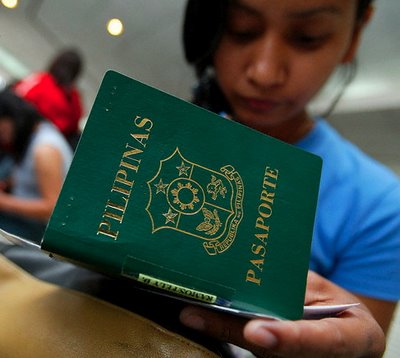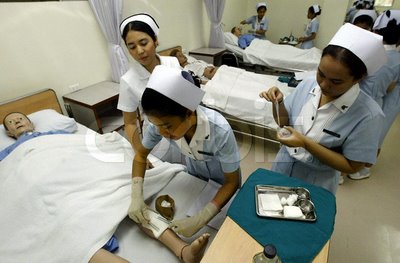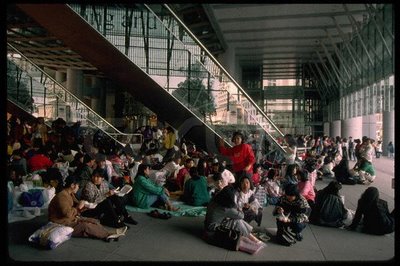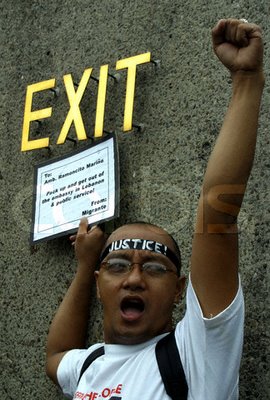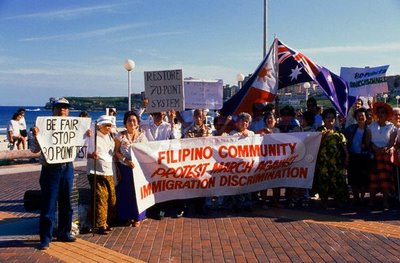
The Context:
The Black Nazarene is a life-sized, dark-skinned statue of Jesus Christ that was supposedly brought from Mexico to the Philippines in the early 1600’s. The statue is presently enshrined in the Quiapo Church in Manila.
For more than 200 years the Black Nazarene has been placed on a gilded carriage every January and hauled through the streets of Quiapo by male devotees dressed in maroon and gold. People who touch the Nazarene are reported to sometimes be healed of diseases. A number of faithful usually collapse and faint during the ritual, some have died.
Observers throw towels to those guarding the statue in hopes of having them rubbed against the Nazarene and absorbing some of it’s miraculous power, or at least walking away with a good luck charm.
The procession and the accompanying Feast of the Black Nazarene take place every January 9th. It is one of the largest festivals in the Philippines.
Source- Wikipedia
A Personal Account:
*Many of these pictures were taken in low light. Click the images to see larger versions.
Stepping off the subway, I find myself darting through a sea of followers, burgundy and gold flashing in the afternoon sun, bare feet dark from unholy residue. I kept a brisk pace dodging and weaving through streets choked with honking, eccentric jeepneys and idling tricycles buzzing like a menacing swarm of mosquitoes awaiting its victim.
Balls of flame spewed from the mouths of roaming transvestite troupes, holding the crowd in awe for a fleeting moment with brilliant bursts of flaming liquid burning precariously close to the messy jumble of electric wires hanging from above.


The crowd is infinite, endless- a unified mass of individuals filling the narrow streets, alleys, and plazas of Quiapo awaiting a precious few seconds when they will see and maybe even touch the sacred Nazarene.

After weaving my way through the masses, I finally reach my destination- a balcony above the chaos, a vantage point to watch this spectacle, this show of devotion and faith unfold before my eyes.
The never-ending stream of people flowed over the pavement as the sun dipped below the horizon and darkness enveloped the city.
Banners and flags dotted the crowd, clans marching to war, seeking repentance, hoping to experience suffering for a better tomorrow, for good luck, for a miracle. The noise builds to a steady buzz, in the distance there are cheers and yells, lights and towels flying, firecrackers snap and pop.


Enter the ropes- snaking ahead of the main attraction like the tentacles of a giant squid. The men grasp them as if their lives depended on it, pulling the Nazarene through the streets in hopes that their physical exertion will translate into good luck in the New Year.
Pushing and shoving commences. Men push, pry, and prod trying to loosen the grip of those holding the ropes, fighting for a chance to strain and struggle. Those holding the ropes close their eyes and rest on each other, sucking in the experience, praying.

The energy escalates further. The buzz is quickly becoming a din. The shouts are only a block away. The ropes writhe with men clinging on for life, like army ants carrying their prey back to the nest.
A loud bell pierces the darkness- it is here.
A large cross, white and gold flash from the carriage, long ropes, and a black Jesus. Cheers erupt from the crowd. Towels flutter like ghosts in the wind, caught, rubbed, and released back to the owner to take home and cherish. Flash bulbs sparkle and illuminate the scene. Sweat, passion, faith, aggression, pain, pandemonium- the air is electric.


Those behind the carriage begin to push it forward.
The Nazarene moves off into the night as does the noise and calamity. Chaos is replaced by tranquility as the street is filled with hundreds of candle bearing followers. Silence. Light. The soft glow illuminating the faces, the emotions of those marching- the hot ember of adrenaline slowly cools.


Adobo, pancit mollo, and biko fill my stomach. Conversation between strangers follows. Eventually the crowd withers away and powerful fireworks rock the neighborhood. It is time to make my exit.
I say thank you to my gracious hosts and once again dart through the streets. Dodging explosions and ambulances, past the countless vendors of pirated computer programs and pornography, I move towards home, slipping away into the night.


